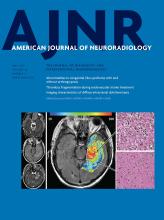Research ArticlePediatric Neuroimaging
Brain Development in Fetuses of Mothers with Diabetes: A Case-Control MR Imaging Study
F.C. Denison, G. Macnaught, S.I.K. Semple, G. Terris, J. Walker, D. Anblagan, A. Serag, R.M. Reynolds and J.P. Boardman
American Journal of Neuroradiology May 2017, 38 (5) 1037-1044; DOI: https://doi.org/10.3174/ajnr.A5118
F.C. Denison
aFrom the Medical Research Council Centre for Reproductive Health (F.C.D., D.A., A.S., J.P.B.), University of Edinburgh, Queen's Medical Research Institute, Edinburgh, UK
G. Macnaught
bClinical Research Imaging Centre (G.M., S.I.K.S.)
S.I.K. Semple
bClinical Research Imaging Centre (G.M., S.I.K.S.)
cUniversity/British Heart Foundation Centre for Cardiovascular Science (S.I.K.S., R.M.R.)
G. Terris
eSimpson Centre for Reproductive Health (G.T., J.W.), Royal Infirmary, Edinburgh, UK.
J. Walker
eSimpson Centre for Reproductive Health (G.T., J.W.), Royal Infirmary, Edinburgh, UK.
D. Anblagan
aFrom the Medical Research Council Centre for Reproductive Health (F.C.D., D.A., A.S., J.P.B.), University of Edinburgh, Queen's Medical Research Institute, Edinburgh, UK
dCentre for Clinical Brain Sciences (D.A., J.P.B.), University of Edinburgh, Edinburgh, UK
A. Serag
aFrom the Medical Research Council Centre for Reproductive Health (F.C.D., D.A., A.S., J.P.B.), University of Edinburgh, Queen's Medical Research Institute, Edinburgh, UK
R.M. Reynolds
cUniversity/British Heart Foundation Centre for Cardiovascular Science (S.I.K.S., R.M.R.)
J.P. Boardman
aFrom the Medical Research Council Centre for Reproductive Health (F.C.D., D.A., A.S., J.P.B.), University of Edinburgh, Queen's Medical Research Institute, Edinburgh, UK
dCentre for Clinical Brain Sciences (D.A., J.P.B.), University of Edinburgh, Edinburgh, UK

REFERENCES
- 1.↵
- 2.↵
- 3.↵
- Stehbens JA,
- Baker GL,
- Kitchell M
- 4.↵
- Nomura Y,
- Marks DJ,
- Grossman B, et al
- 5.↵
- 6.↵
- Dionne G,
- Boivin M,
- Séguin JR, et al
- 7.↵
- Kalhan S,
- Parimi P
- 8.↵
- Pagán A,
- Prieto-Sánchez MT,
- Blanco-Carnero JE, et al
- 9.↵
- Larqué E,
- Demmelmair H,
- Gil-Sánchez A, et al
- 10.↵
- Limperopoulos C,
- Tworetzky W,
- McElhinney DB, et al
- 11.↵
- 12.↵
- 13.↵
- Pier DB,
- Levine D,
- Kataoka ML, et al
- 14.↵
- 15.↵
- 16.↵
- 17.↵
- 18.↵
- 19.↵
- 20.↵
- Taylor-Clarke M
- 21.↵
- 22.↵
- 23.↵
- Hanrahan JD,
- Cox IJ,
- Azzopardi D, et al
- 24.↵
- Amess PN,
- Penrice J,
- Wylezinska M, et al
- 25.↵
- Filippi CG,
- Uluğ AM,
- Deck MD, et al
- 26.↵
- Counsell SJ,
- Allsop JM,
- Harrison MC, et al
- 27.↵
- 28.↵
- 29.↵
- Boardman JP,
- Counsell SJ,
- Rueckert D, et al
- 30.↵
- Inder TE,
- Warfield SK,
- Wang H, et al
- 31.↵
- Boardman JP,
- Craven C,
- Valappil S, et al
- 32.↵
- Ullman H,
- Spencer-Smith M,
- Thompson DK, et al
- 33.↵Scottish Intercollegiate Guidelines Network. Management of diabetes: a national clinical guideline, 2014. Edinburgh. http://www.sign.ac.uk/pdf/sign116.pdf. Accessed May 30, 2016.
- 34.↵
- 35.↵
- Ratiney H,
- Sdika M,
- Coenradie Y, et al
- 36.↵
- 37.↵
- 38.↵
- Boardman JP,
- Counsell SJ,
- Rueckert D, et al
- 39.↵
- 40.↵
- Serag A,
- Aljabar P,
- Ball G, et al
- 41.↵
- Serag A,
- Kyriakopoulou V,
- Rutherford MA, et al
- 42.↵
- 43.↵
- Whitehead AL,
- Julious SA,
- Cooper CL, et al
- 44.↵
- Santhakumari R,
- Reddy IY,
- Archana R
- 45.↵
- 46.↵
- Kok RD,
- van den Berg PP,
- van den Bergh AJ, et al
- 47.↵
- Righini A,
- Bianchini E,
- Parazzini C, et al
- 48.↵
- 49.↵
- Alvarez-Linera J
- 50.↵
- Azzopardi D,
- Robertson NJ,
- Bainbridge A, et al
In this issue
American Journal of Neuroradiology
Vol. 38, Issue 5
1 May 2017
Advertisement
F.C. Denison, G. Macnaught, S.I.K. Semple, G. Terris, J. Walker, D. Anblagan, A. Serag, R.M. Reynolds, J.P. Boardman
Brain Development in Fetuses of Mothers with Diabetes: A Case-Control MR Imaging Study
American Journal of Neuroradiology May 2017, 38 (5) 1037-1044; DOI: 10.3174/ajnr.A5118
0 Responses
Jump to section
Related Articles
- No related articles found.
Cited By...
This article has not yet been cited by articles in journals that are participating in Crossref Cited-by Linking.
More in this TOC Section
Similar Articles
Advertisement











